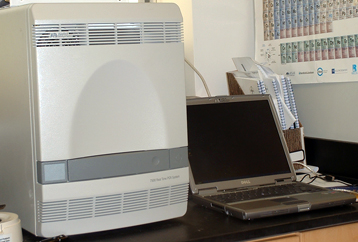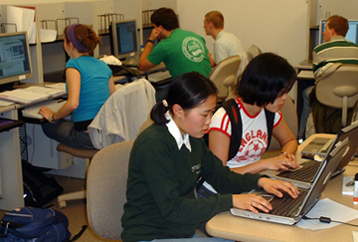

| |
||
ABI 7500 Real-Time PCR Instrument |
|
 |
 |
Kenyon's ABI 7500 Real-Time PCR Instrument |
Students in BIOL 264 Analyze Data |
Measuring Gene Expression by Real-Time PCR |
Real Time PCR, a key technical development in the genomics revolution, has emerged as the preferred method for quantifying nucleic acids and measuring changes in the expression of specific genes. This technique couples the polymerase chain reaction (PCR), which can generate multiple copies of cDNAs derived from target RNA molecules, and fluorescent probes, which increase emission in direct proportion to the accumulation of the amplified RNA target. By measuring fluorescence from probes corresponding to specific genes, one can quantitatively compare mRNA expression in different cell or tissue types, different developmental stages or resulting from different environmental conditions. A Real Time PCR instrument measures probe fluorescence during each cycle of PCR, enabling comparison of product abundance during the log-linear phase of the reaction, when differences between samples are most apparent. Furthermore, the technique is dramatically more sensitive than traditional means of quantifying mRNA like northern blots or nuclease protection assays. With support from Kenyon College’s HHMI Education Grant, the Biology Department acquired an Applied Biosystems 7500 Real Time PCR instrument (ABI 7500) in January 2005. The instrument is used in laboratory classes, student projects, and faculty-led research programs. The ABI 7500 also plays an important role in verifying data obtained in genomic-scale gene expression experiments conducted in the HHMI-supported cDNA microarray undergraduate research collaboration. |
Links: |
|
From Kenyon's Alumni Bulletin: Biologists Use New Genetics Research Tool |
|